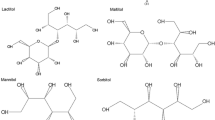Abstract
The effect on energy metabolism of delayed absorption of starch by inhibition of α-amylase was examined by considering levels of plasma glucose and 3-hydroxybutyric acid (3-OHBA) in rats. Addition of α-amylase inhibitor (αAI) to a high starch diet delayed the plasma glucose response after feeding: peak plasma glucose levels in the control group occurred 15 min after feeding, whereas in the αAI group this peak did not occur until 30 min after. The total plasma glucose response was not different between the two groups. Plasma 3-OHBA levels 1 day after food restriction increased approximately five-fold in both groups. After 3 days of food restriction, the αAI group maintained the same level of plasma 3-OHBA as after 1 day of food restriction, while the control group showed significantly decreased levels of 3-OHBA. After 3 days of food restriction, plasma insulin levels were significantly decreased in the αAI group compared with the corresponding levels of the control group and with levels before the restriction. There was no significant difference in body weight between the two groups. These findings suggest that delayed hyperglycemia due to delayed absorption of starch following αAI loading may attenuate insulin secretion, leading to altered metabolism of 3-OHBA during the delayed response to energy deficit.
Similar content being viewed by others
References
Haber, G. B., Heaton, K. W., Murphy, D., and Burroughs, L. F., Lancet2 (1977) 679.
Jenkins, D. J. A., Taylor, R. H., Goff, D. V., Fielden, H., Misiewicz, J. J., Sarson, D. L., Bloom, S. R., and Alberti, K. G. M. M., Diabetes30 (1981) 951.
Bowman, D. E., Science102 (1945) 358.
Kneen, E., and Sandstedt, R. M., J. Am. chem. Soc.65 (1943) 1247.
Marshall, J. J., and Lauda, C. M., J. biol. Chem.250 (1975) 8030.
Puls, W., and Keup, U., Diabetologia9 (1973) 97.
Bo-Linn, G. W., Santa Ana, C. A., Morawski, S. G., and Fordtran, J. S., N. Engl. J. Med.307 (1982) 1413.
Carlson, G. L., Li, B. U. K., Bass, P., and Olsen, W. A., Science219 (1983) 393.
Parrilla, R., Pflügers Arch.374 (1978) 3.
Sakata, T., Oomura, Y., Fukushima, M., Tsutsui, K., Hashimoto, K., Kuhara, T., and Matsumoto, I., Brain Res. Bull.5 Suppl. 4 (1980) 23.
Arase, K., Sakata, T., Oomura, Y., Fukushima, M., Fujimoto, K., and Terada, K., Physiol. Behav.33 (1984) 261.
Arase, K., and Sakata, T., in: Progress in Obesity Research 1990, p. 537. Eds Y. Oomura, S. Tarui, S. Inoue and T. Shimazu. John Libbey, London 1991.
Fritz, I. B., and Lee, L. P. K., in: Handbook of Physiology: Section 7: Endocrinology, vol. 1, p. 579. Eds R. O. Greep and E. B. Astwood. American Physiological Society, Washington DC 1972.
Banwell, J. G., Abramowsky, C. R., Weber, F., Howard, R., and Boldt, D. H., Dig. Dis. Sci.29 (1984) 921.
Sakata, T., Tsutsui, K., Fukushima, M., Arase, K., Kita, H., Oomura, Y., Ohki, K., and Nicolaidis, S., Physiol. Behav.27 (1981) 401.
Tsutsui, K., Fukushima, M., Arase, K., and Sakata, T., Igaku no Ayumi117 (1981) 33.
Trinder, P., Ann. clin. Biochem.6 (1969) 24.
Coulston, A. M., Hollenbeck, C. B., Liu, G. C., Williams, R. A., Starich, G. H., Mazzaferri, E. L., and Reaven, G. M., Am. J. clin. Nutr.40 (1984) 965.
Fukushima, M., Tsutsui, K., Kodama, J., Sakata, T., Goto, M., and Teranishi, T., Physiol. Behav.22 (1979) 1029.
Williamson, D. H., Mellanby, J., and Krebs, H. A., Biochem. J.82 (1962) 90.
Morgan, C. R., and Lazarow, A., Diabetes12 (1963) 115.
Bates, M. W., Krebs, H. A., and Williamson, D. H., Biochem. J.110 (1968) 655.
Boivin, M., Flourie, B., Rizza, R. A., Go, V. L. W., and DiMagno, E. P., Gastroenterology94 (1988) 387.
Author information
Authors and Affiliations
Rights and permissions
About this article
Cite this article
Doi, T., Yoshimatsu, H., Katsuragi, I. et al. Alpha-amylase inhibitor increases plasma 3-hydroxybutyric acid in food-restricted rats. Experientia 51, 585–588 (1995). https://doi.org/10.1007/BF02128748
Received:
Revised:
Accepted:
Published:
Issue Date:
DOI: https://doi.org/10.1007/BF02128748




